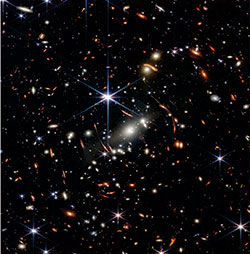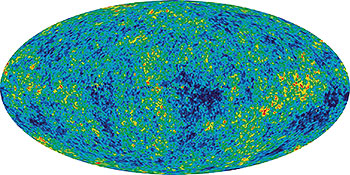|
|
DARK SKY HAPPENINGS -September 2023
Moab
UT (at City Hall)
38O34’ N Latitude
109O33’ W Longitude
4048 ft - 1234 m |
Looking Beyond the Stars
Adapted from an article by Brian Kruse
Looking up in awe at the night sky, the stars and planets are bright points against a dark background. While the number of stars seems immense, the actual number is measurable in the thousands, entirely from our own Milky Way Galaxy. Both the Hubble telescope and the James Webb Space Telescope (Webb) have revealed that dark background is populated with as many galaxies as there are stars in the Milky Way. Why can’t we see them?
Much like looking into a dense forest where every line of sight has a tree, every direction we look in the sky has billions of stars. Heinrich Wilhelm Olbers, an early 19th century German astronomer, posed what we call the Olbers Paradox: if the Universe is infinitely old and static, then stars should be everywhere, so why is the night sky dark? The observable dark sky leads us to debate the nature of the Universe—is it eternal and static or dynamic and evolving?
The discovery of the Cosmic Microwave Background in the 1960s finally settled the debate, though various lines of evidence for an evolving universe had built up over the previous half century. The equations of Einstein’s General Theory of Relativity suggested a dynamic universe. Edwin Hubble used the cosmic distance ladder discovered by Henrietta Swan Leavitt to show that distant galaxies are moving away from us.
Now, we understand that the Universe has a finite age and size, with the speed of light having a definite value. Due to the expansion of the Universe, the light from the oldest, most distant galaxies is shifted towards the longer wavelengths of the electromagnetic spectrum. Thus, the farther an object is from us, the redder it appears. The Webb telescope detects light from distant objects in infrared light, beyond the visible spectrum. Other telescopes detect light at still longer wavelengths—radio and microwaves. The farther back we look, the more things are shifted. If our eyes could see microwaves, we would behold a sky blazing with the light of the hot, young Universe – the Cosmic Microwave Background.
 |
 |
| NASA’s James Webb Space Telescope has produced the deepest and sharpest infrared image of the distant universe to date. Known as Webb’s First Deep Field, this image of galaxy cluster SMACS 0723 is overflowing with detail. This slice of the vast universe is approximately the size of a grain of sand held at arm’s length by someone on the ground. (Image Credit: NASA, ESA, CSA, STScI) https://bit.ly/webbdeep |
The oldest light in the universe, called the cosmic microwave background, as observed by the Planck space telescope is shown in the oval sky map. The cosmic microwave background was imprinted on the sky when the universe was just 380,000 years old. It shows tiny temperature fluctuations that correspond to regions of slightly different densities, representing the seeds of all future structure: the stars and galaxies of today. (Image credit: ESA and the Planck Collaboration - D. Ducros) https://go.nasa.gov/3qC4G5q |
Sunrise-Sunset
(The time of sunrise and sunset assumes a flat horizon. Actual time may
vary depending upon the landscape.) |
 |
MOON HAPPENINGS
September 6 - Third Quarter at 4:21 pm
September 14 - New Moon at 7:39 pm
September 22 - First Quarter at 1:31 pm
September 29 - Full Moon at 3:57 am
|
Moab Dark Skies mission is to promote the appreciation and conservation of Moab’s valuable and rare dark skies. Moab Dark Skies was established by the Friends of Arches and Canyonlands Parks in conjunction with the National Park Service and Utah State Parks Division of Natural Resources
For more information, check out our
Facebook page |
|
|
|
|
|
|
|
© 2002-2024 Moab Happenings. All rights
reserved.
Reproduction of information contained in this site is
expressly prohibited.
|
|